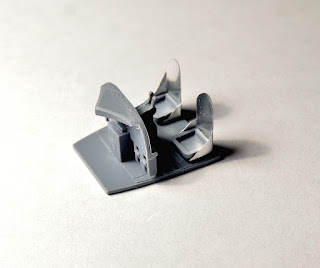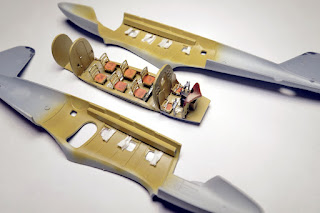Another splendid Fine Molds 1/48 Ki-43-III Ko, this time Guillermo kindly sharing images of his build of the kit to represent a rather battered aircraft of Hiko Dai 204 Sentai as photographed at Matsuyama airfield on the island of Formosa (now Taiwan) in August 1945. The tail number '01' has led to speculation that this aircraft was perhaps flown by 1st Chutai leader Lt Tatsukichi Nishimoto or even the Hikotai leader Capt Wataru Takahashi. Although no other obvious command markings are visible instructions were given during mid-1945 for formation leaders to avoid the display of garish identity markings which might lead to them being singled out in combat, instructions which were not always followed.
The 204th, which had been re-designated a Hiko Sentai from its previous
Kyôdô (教導 - instructional) Hiko Sentai status in February 1944, lost all Ki-43-II aircraft sent to the Philippines campaign, with 17 pilots including all Chutai leaders being killed there. The surviving flying personnel returned to Mito, Japan, by transport plane in December 1944. At Mito the unit re-equipped with the III Ko before moving to Saigon, Indo-China in February 1945. In April part of the unit moved to Formosa and was assigned to special attack duties as the
Makoto (誠 - honesty or sincerity) 204 Sentai to participate in the Okinawa campaign and in July 1945 the main force of the unit joined it there. At the end of the war surviving personnel of the unit still in Saigon were transferred into the 126th Airfield Battalion and Dai 64 Hiko Sentai. A 204th Hayabusa II in Burma displaying the previous form of unit insignia is shown
here. It is now known that the white '
Chinzei Hachiro' arrow flight unit insignia on the fuselage, white painted fin tip, wingtips and possibly forward part of the spinner on that Ki-43-II aircraft denoted the 1st Chutai, with the 2nd and 3rd Chutai markings applied in red and yellow respectively.
After first painting the cockpit aotake Gulllermo re-painted it using Vallejo Model Air 71.016 FS 34088 to represent the late war olive drab colour which was also applied to the exterior upper surfaces. The seat was finished aluminium and other details painted in accordance with the Aero Detail # 29 book on Hayabusa, For the under surface Guillermo used Vallejo Model Air 71.326 IJA Grey Green (which despite the name is a warm, slightly brownish grey not to be confused with 71.321 IJA Light Grey Green). Revell Lufthansa Yellow was used for the wing leading edge IFF strips and Vallejo 70.830 WWII German Green for the propeller. The drop tanks were painted with a mix of Medium Sea Grey and Medium Blue with their data markings hand-painted using Vallejo paints.

Guillermo carefully replicated the weathering and chipping indicated in the photographs of '01' by first applying two aluminium paints, Vallejo for the fuselage and Tamiya XF-16 enamel for the wings, together with some pre-shading of panel lines. Vallejo liquid masking was then applied with a sponge. Afterwards some areas of chipping were repaired and improved, painting some irregular spots and re-touching them with Vallejo aluminium. The hinomaru and other markings were applied by paint using Colourcoats RAF Roundel Red and Tamiya XF-2 Flat White, with only the decals for '01' and minor markings used. Weathering was achieved Winsor and Newton oil paints with some pigments for soil and dust effects on the tyres. Note how the fin leading edge marking extends a point along the fuselage spine and 'wings' onto the tailplanes, a detail not always captured in illustrations or decal sheets. In some depictions the red flash is shown with a narrow yellow border.

Guillermo's primed model tellingly reveals how the basic Hayabusa airframe remained relatively unchanged throughout production.
And compels a repeat reiteration against the use of Ko and Otsu designations applied to the Ki-43-II as they persist in the modelosphere and with kit and decal manufacturers. The Ko, Otsu, etc., suffix designations, sometimes rendered as a, b, c, etc., in English sources, were most usually used by IJAAF to denote armament variations in fighters which do not apply to the Ki-43. The detail differences in the II series were production changes to the airframe and engine/cowling and in Japanese references these sub-types are often divided by their features into early, mid and late production types with the II Kai as the final Nakajima-built type, all using the character ki (期) which means period but is sometimes given as 'production' in English. Thus:-
初期 - (hatsu ki) = first period (Ki-43-II with annular oil cooler and long Ki-43-I wingspan)
中期 - (naka ki) = middle period (Ki-43-II with enlarged under cowling cooler and shortened wingspan)
後期 - (nachi ki) = later period (Ki-43-II with rearwards thrust exhaust stacks and landing light in port wing leading edge)
末期 - (matsu ki) = end or final period (this is the Ki-43-II Kai with individual thrust exhaust stacks but note that a further refinement was the provision of water-methanol boost to the Kai)
Only the main features of each sub-type are noted above but not all the additional detail changes, especially of armament, armour and other protective equipment/enhancements. The official IJAAF table of aircraft designations ('Table of Aircraft Desgnations and Armament, Army Air Headquarters Secret' # 16979 of 9 December 1943) makes no such distinctions as it does for other fighter types, whilst the official report 'Study of Increase of Armor, Bullet-Proofing, Fire Extinguishing Equipment and Armament on Various Aircraft; Aircraft Section; Supply Depot (Luzon)' of 22 March 1944 lists various upgrades to the II as production changes, detailing dates and first change serial numbers but no Ko or Otsu suffix are tabled. The incremental improvements in Hayabusa fuel and armour protection also counter that other persistent belief in the aircraft's inherent vulnerability. In a report on combat in Burma on 20 January 1944 the Japanese command expressed satisfaction with the improvement in fuel and armour protection for the Type 1 fighter (Hayabusa) from serial # 5800, noting that one aircraft had returned safely with 39 hits and no doubt that was one of the 23 Oscars of 50 and 204 Sentai's 47 sortied that were claimed as destroyed, probable or damaged on that day. The two Spitfire squadrons involved, 136 and 607, claimed 7 Oscars destroyed, 8 probables and 8 damaged. The Japanese reported one 'self destroyed' and two failed to return for a total of three lost. They also claimed 9 Spitfires (or 'P-40s') destroyed and 6 uncertain, whereas only two were lost. Three Spitfires returned damaged, one from a head-on attack by another Spitfire which was admitted, with two of their pilots wounded. After that digression onwards with Guillermo's excellent interior details.




With special thanks to Guillermo for sharing these images and details of his build.
Image credit: All model photos © 2023 Guillermo; Photo via Guillermo



















































